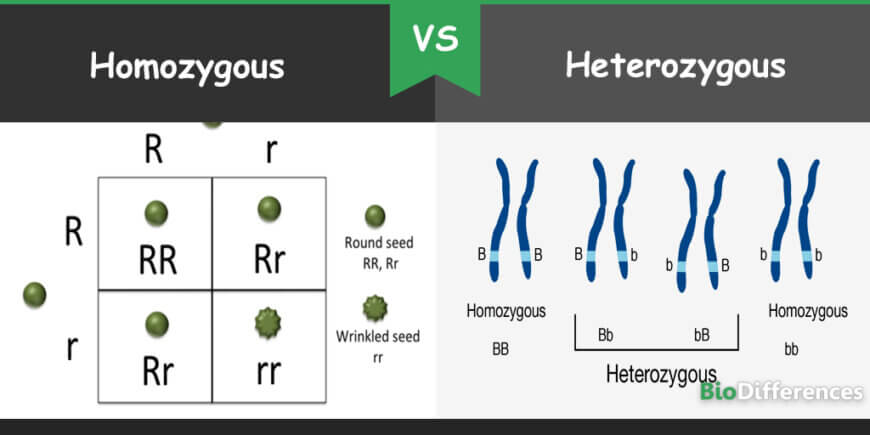Terms homozygous and heterozygous feature in genetics and inheritance. Individual organisms having two identical alleles are called homozygous, whereas individual forms having different alleles are called heterozygous. Alleles are different types of genes. Alleles or genes ultimately show some traits. A homozygous feature is when the same kind of two alleles associate to develop a trait. In contrast, a heterozygous trait is when different types of two alleles associate to form a trait.

All humans are diploid organisms having two copies of each chromosome, which inherit a complete set of the chromosome from the mother and a full set from the father. These two chromosomes correspond with each other and are called homologous chromosomes. Even the locus (location of the gene) is the same as these genes in homologous chromosomes.
For example, organisms take the case of hair color. We have two alleles for this gene. One allele codes for black color (A) and the other allele codes for brown color (a). The homologous pair of chromosomes contain either the same alleles (AA or aa), both black or brown or different alleles (Aa) brown and black. The alleles are of two types dominant or recessive. The dominant allele shows its characteristics, whereas the recessive allele’s characteristics do not appear.
Contents
Comparison Chart
| Basis for Comparison | Homozygous | Heterozygous |
| Definition | Homozygous can be defined as an individual having two identical alleles of a particular gene. | Heterozygous can be defined as an individual having two different alleles of a particular gene. |
| Etymology | Homo means “same and zygous means “zygote” | Hetero means “different” and zygous means “zygote” |
| Results in | Results in similar individuals | Results in dissimilar individuals |
| It carries | Carries similar alleles | Carries dissimilar individuals |
| Type of alleles | Either dominant or recessive alleles | Both dominant and recessive alleles |
| Type of gametes produced | One type of gametes are produced | Two types of gametes are produced |
| Types | Two types:
Homozygous dominant and homozygous recessive |
Three types:
Complete dominance, incomplete dominance, and codominance |
What is Homozygous?
The word “homo” means “same” and “zygous” means zygote of a specified kind. So we can explain it more by saying that when both alleles present on the homologous chromosomes for a given gene are the same, they are known homozygous. Homozygous are further of two types; dominant homozygous and recessive homozygous. In dominant homozygous, two identical alleles dominant, whereas in recessive homozygous, the two identical alleles are both recessive. The genes of an individual can show mutation over time. If the same mutation happens in both alleles of the homozygous pair, the variation is called a homozygous mutation. If the mutation takes place in only one allele in the homozygous pair, the situation is called a heterozygous mutation.
When two genes share detectable sequence similarities in proteins they encode, are homologs. If two homologous genes (alleles) occur in the same species as they are called to be paralogous, and their protein products are paralogs.
An organism is said to be homozygous at a particular locus when it brings two identical copies of the gene affecting a characteristic present on the two reciprocal homologous chromosomes. Such a cell or organism is called homozygous.
What is Heterozygous?
The word “hetero” means “different,” and “zygous” means having zygotes of a specified kind. So we explain it by saying that when both the alleles (genes) present on the homologous chromosomes for a given gene different. For instance, one chromosomes in homologous pair have brown hair (A), and another chromosome has black hair (a), then the resultant genotype is Aa.
Heterozygous can be of two types; codominance, semidominance, or incomplete dominance. Sometimes, a heterozygous allele pair contains two equally dominant genes that express themselves through the development of two different proteins. This case is called codominance. Both traits are represented in the phenotype. For example, if we cross red-flowered and white-flowered plants, then the codominance will be if the offspring would have both red and white-colored flowers. The AB blood group is an excellent example of codominance. In this, both antigen A and antigen B are expressed in the red blood cells.
In semidominance or incomplete dominance, a phenotype is a mixture of the two genes that produce a new phenotype. For example, if we cross the red-flowered and white-flowered plants, the offspring would have pink-colored flowers.
Key Differences
- If the organism has two copies of each gene that may be identical allele are called homozygous, whereas the body carries two copies of each gene (both dominant and recessive) are called heterozygous.
- Homozygous results in similar individuals, whereas heterozygous results in dissimilar individuals.
- Homozygous bears similar alleles of a trait (AA or aa), whereas heterozygous bears different allele (Aa).
- Homozygous can have either dominant or recessive allele but not both at the same time, whereas heterozygous has both alleles; dominant and recessive allele at the same time.
- Only one kind of gamete is produced in homozygous, whereas in heterozygous, two types of gametes are produced.
- Homozygous does not show extra vigor, whereas heterozygous shows extra vigor, e.g., heterosis or hybrid vigor.
- In homozygous, self-breeding results in the same trait or characteristic over generations, whereas self-breeding in heterozygous results in different combinations of features.
- In homozygous, homozygous dominant and homozygous recessive are two types whereas in heterozygous, complete dominance, incomplete dominance and codominance are three examples.
Conclusion
In conclusion, homozygous and heterozygous are the two terms used in the identification of the traits of the organisms. When two organisms breed, they produce a feature that is a combination of either a series of dominant or recessive alleles. The way these alleles or genes are combined will show as they are either homozygous or heterozygous.